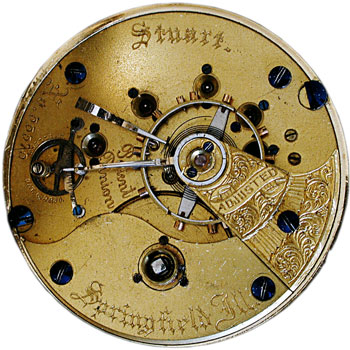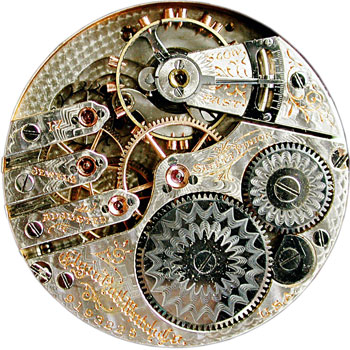Collectors Weekly: With pocket watches, what else determines rarity besides scarcity?
McIntyre: There are some very rare watches that aren’t all that great. There was a company in Massachusetts called the Auburndale Watch Company, and they made two watches. They made the Auburndale Rotary and the Auburndale Timer. The company was only in business for three years.
They probably made a couple of hundred of the Auburndale Rotary and 500 of the Auburndale Timer, but you can still buy those watches for a relatively small amount of money. You can buy a Timer for a few hundred dollars, and you can buy the Rotary for maybe $1,500 to $2,000, as opposed to a very fine railroad watch produced by Hamilton in the 1950s, one of which sold two years ago for $40,000. So the two watches are maybe equally rare, but one’s worth a thousand dollars and one’s worth $40,000. It’s the quality of the watch itself that makes the biggest difference.
The Waltham 1872 models are not as rare as some of the other watches. They made about 3,000 of those, but they’re far and away the best quality watches that were made in the country. The only ones that come close to them are the watches that Elgin made that they call the 21-jewel convertible watches. Those are about as good as the Waltham 1872 models. Those two are the top-rank of American pocket watches in terms of quality. But there’re 2,000 of the convertibles and there’re a couple of thousand of the ’72 models, so they’re not really super scarce like the McIntyre watch.
There are only maybe four of the McIntyre watches, and the one that has come on the market now twice in the last 50 years sold the first time for about $4,000 and sold the second time for $50,000 plus premiums. If you put scarcity and quality together, the price goes way up.
Then you get into things that don’t make any sense to collectors like me. Modern wristwatches that are just coming on the market by prominent makers in Switzerland sell for anywhere from $25,000 to $100,000. You have to have your name on the list for five years to get one. The people that want those pay a lot of money for them.
Collectors Weekly: When pocket watches were still being made, how often were they coming out with new models?
McIntyre: Waltham produced a new model in each size and each class of watch. So for their principal men’s watch, they had two kinds: a full-plate line of watches that was for working men, and the three-quarter plate, slightly smaller, 16-size watches. They produced a new model in each of those about every three or four years, although there were some long gaps. There was a full-plate model produced in 1857. The next full-plate model wasn’t until 1877, but then in 1879, there was another one, and then in 1883 there was another one, and the last one in 1892. Those were the 18-size full-plate watches.
The first of the 16-size watches was produced in 1860, and then another model was produced in 1868 and then another in 1872. Then there was a long gap until 1888, and the last one was in 1908. If you averaged out those numbers, I guess that turns out to be close to a new watch for the men’s market every 10 years. There were smaller watches for women that were being produced at the same time, so maybe it would be fair to say a new watch on average every three or four years.
Waltham always named their models for the year the watch was made, after the first few years. In the very beginning, they called it the full-plate watch and then the key-wind watch of 18-size, but later on, after they had more models than they could deal with that way, they started calling them by the model year. 1868, I believe, was the first time they actually referred to the watch by the model year. Then they went back and assigned model years to all the previous ones.
Elgin called them either by a grade name or a grade number, and Hamilton always called theirs by grade numbers.
Collectors Weekly: What is the grade?
McIntyre: The word is confusing because grade is used as just a name. A grade number is just the same as a name that describes a watch. So the grade 162 Elgin just describes a particular watch; a 168 is not better than a 162, and a 162 is not worse than a 155. They’re arbitrary numbers. The same is true of Hamilton. It can be very confusing.
Waltham, in addition to the models, had grades that were names that applied to many different models. So I collect watches that are American Watch Co. grade. The American Watch Co. grade was introduced in 1859, and they made an American Watch Co. grade watch for the 20-size 1862 model, the 16-size 1860 model, the 16-size 1868 model, the ’72 model, the ’88 model and the ’99 model. Those were all made in American Watch Co. grade. They made some 12-size watches in American Watch Co. grade also. The 1894 bridge model was American Watch Co. grade, 12-size.
Waltham also made a ladies’ watch in 1890 that they called the OM model, but they made that in American Watch Co. Grade, too. So that was the only ladies’ watch that was ever made in this country as officially the highest grade watch made by the company.
All the companies made ladies’ watches, I believe. I can’t think of any exceptions offhand. In general, the interesting thing about ladies’ watches is that they don’t get collected nearly enough. I guess women aren’t as attracted to mechanical things, perhaps. But ladies’ watches generally were made as a piece of jewelry. There were pretty dials and pretty cases and just very plain mechanisms inside them, and those are relatively common. They’re collectible because the case that enclosed it is very pretty.
There’s a few ladies watches at the very top end, and they were made in relatively miniscule quantities. Waltham made some of those, and Elgin and Hamilton and Illinois. They all made a handful of watches in very high grades for ladies, and people should collect them more. There are a few of us that do collect them, and I have some of them on my website under “Small Wonders,” but I haven’t gotten most of them photographed. I have quite a few more that are not on the website.
All the watches on my website are part of my personal collection. There are a handful of watches there that people have let me take pictures of to include to complete the story. The McIntyre watches for example do not belong to me.


No comments:
Post a Comment